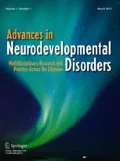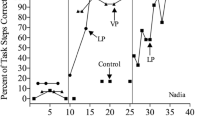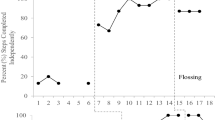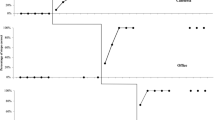Abstract
Objective
The purpose of this study was to examine the effects of point-of-view video prompting (VP) as a self-prompting strategy with a least-to-most prompting (LMP) system on the rapidity of skill acquisition of two students with autism spectrum disorder (ASD) and two students with intellectual disability (ID) when working on school-based vocational tasks.
Methods
We used multiple probes across students design of single-case experimental methodology to examine whether or not causal relation existed between the intervention and students’ vocational skill acquisition and follow-up performance. Target tasks involved both process and basic functional mathematics steps that required students to pay attention to the process of task completion rather than the functional step itself.
Results
All students showed immediate and considerable improvement in skill acquisition between baseline and intervention. Furthermore, all students completed the tasks with an average of over 90% accuracy once the LMP was removed. The four students in this study required two to six intervention trials to reach 100% accuracy without the use of LMP, with a mean of four trials. Tau-U effect size showed a strong effect of the intervention on skill acquisition and follow-up performance.
Conclusions
VP and LMP as a combined intervention can be effective in teaching vocational tasks that involve process steps to students with both ASD and ID. VP can be a useful support for students with ASD and ID in school, community, and employment settings to decrease reliance on adult prompting and increase independence.

Similar content being viewed by others
Change history
09 November 2019
A correction should be made to the procedural reliability and interobserver agreement (IOA) sub-section within the Method section of the paper. In the Method section of the paper, the procedures for reliability and IOA were stated, however, the results were not. The following were the results: Procedural reliability per student for each phase, i.e., baseline, intervention, and follow-up, was 100%. Similarly, IOA for each student per phase was 100%.
09 November 2019
A correction should be made to the procedural reliability and interobserver agreement (IOA) sub-section within the Method section of the paper. In the Method section of the paper, the procedures for reliability and IOA were stated, however, the results were not. The following were the results: Procedural reliability per student for each phase, i.e., baseline, intervention, and follow-up, was 100%. Similarly, IOA for each student per phase was 100%.
References
Alexander, J. L., Ayres, K. M., Smith, K. A., Shepley, S. B., & Mataras, T. K. (2013). Using video modeling on an iPad to teach generalized matching on a sorting mail task to adolescents with autism. Research in Autism Spectrum Disorders, 7, 1346–1357. https://doi.org/10.1016/j.rasd.2013.07.021.
Aljehany, M. S., & Bennett, K. D. (2018). Meta-analysis of video prompting to teach daily living skills to individuals with autism spectrum disorder. Journal of Special Education Technology. https://doi.org/10.1177/0162643418780495.
Allen, K. D., Wallace, D. P., Renes, D., Bowen, S. L., & Burke, R. V. (2010). Use of video modeling to teach vocational skills to adolescents and young adults with autism spectrum disorders. Education and Treatment of Children, 33, 339–349. https://doi.org/10.1353/etc.0.0101.
Allen, K. D., Burke, R. V., Howard, M. R., Wallace, D. P., & Bowen, S. L. (2012). Use of audio cuing to expand employment opportunities for adolescents with autism spectrum disorders and intellectual disabilities. Journal of Autism and Developmental Disorders, 42, 2410–2419. https://doi.org/10.1007/s10803-012-1519-7.
Alwell, M., & Cobb, B. (2009). Functional life skills curricular interventions for youth with disabilities. Career Development for Exceptional Individuals, 32, 82–93. https://doi.org/10.1177/0885728809336656.
Ault, M. J., & Griffen, A. K. (2013). Teaching with the system of least prompts. Teaching Exceptional Children, 45, 46–53. https://doi.org/10.1177/004005991304500305.
Banda, D., Dogoe, M., & Matuszny, R. (2011). Review of video prompting studies with persons with developmental disabilities. Education and Training in Autism and Developmental Disabilities, 46, 514–527.
Bennett, K. D., Ramasamy, R., & Honsberger, T. (2013). The effects of covert audio coaching on teaching clerical skills to adolescents with autism spectrum disorder. Journal of Autism and Developmental Disorders, 43, 585–593. https://doi.org/10.1007/s10803-012-1597-6.
Bennett, K. D., Aljehany, M. S., & Altaf, E. M. (2017). Systematic review of video-based instruction component and parametric analyses. Journal of Special Education Technology, 32(2), 80–90. https://doi.org/10.1177/0162643417690255.
Bereznak, S., Ayres, K. M., Mechling, L. C., & Alexander, J. L. (2012). Video self-prompting and mobile technology to increase daily living and vocational independence for students with autism spectrum disorders. Journal of Developmental and Physical Disabilities, 24, 269–285. https://doi.org/10.1007/s10882-012-9270-8.
Burke, R. V., Allen, K. D., Howard, M. R., Downey, D., Matz, M. G., & Bowen, S. L. (2013). Tablet-based video modeling and prompting in the workplace for individuals with autism. Journal of Vocational Rehabilitation, 38, 1–14. https://doi.org/10.3233/JVR-120616.
Cannella-Malone, H. I., Wheaton, J. E., Wu, P., Tullis, C. A., & Park, J. H. (2012). Comparing the effects of video prompting with and without error correction on skill acquisition for students with intellectual disability. Education and Training in Autism and Developmental Disabilities, 47, 332–344.
Carnine, D., Silbert, J., & Kameenui, E. J. (1990). Direct instruction (2nd ed.). New York: Macmillan.
Cimera, R., & Burgess, S. (2011). Do adults with autism benefit monetarily from working in their communities? Journal of Vocational Rehabilitation, 34, 173–180. https://doi.org/10.3233/JVR-2011-0545.
Cumming, T. M., & Rodríguez, C. D. (2017). A meta-analysis of mobile technology supporting individuals with disabilities. The Journal of Special Education, 51, 164–176. https://doi.org/10.1177/0022466917713983.
Domire, S. C., & Wolfe, P. (2014). Effects of video prompting techniques on teaching daily living skills to children with autism spectrum disorders: a review. Research and Practice for Persons with Severe Disabilities, 39, 211–226. https://doi.org/10.1177/1540796914555578.
Farley, M. A., McMahon, W. M., Fombonne, E., Jenson, W. R., Miller, J., Gardner, M., Block, H., Pingree, C. B., Ritvo, E. R., Ritvo, R. A., & Coon, H. (2009). Twenty-year outcome for individuals with autism and average or near-average cognitive abilities. Autism Research, 2, 109–118. https://doi.org/10.1002/aur.69.
Finke, E. H., Davis, J. M., Benedict, M., Goga, L., Kelly, J., Palumbo, L., Peart, T., & Waters, S. (2017). Effects of a least-to-most prompting procedure on multisymbol message production in children with autism spectrum disorder who use augmentative and alternative communication. American Journal of Speech-Language Pathology, 26, 81–98. https://doi.org/10.1044/2016_ajslp-14-0187.
Fletcher-Watson, S. (2014). A targeted review of computer-assisted learning for people with autism spectrum disorder: toward a consistent methodology. Review of Research in Autism and Developmental Disorders, 1, 87–101. https://doi.org/10.1007/s40489-013-0003-4.
Gardner, S. J., & Wolfe, P. S. (2015). Teaching students with developmental disabilities daily living skills using point-of-view modeling plus video prompting with error correction. Focus on Autism and Other Developmental Disabilities, 30, 195–207. https://doi.org/10.1177/1088357614547810.
Grynszpan, O., Weiss, P. L., Perez-Diaz, F., & Gal, E. (2014). Innovative technology- based interventions for autism spectrum disorders: a meta-analysis. Autism, 18, 346–361. https://doi.org/10.1177/1362361313476767.
Harrison, P. L., & Oakland, T. (2015). Adaptive behavior assessment system (3 rded.). Torrance: Western Psychological Services.
Hendricks, D. (2010). Employment and adults with autism spectrum disorders: challenges and strategies for success. Journal of Vocational Rehabilitation, 32, 125–134. https://doi.org/10.3233/JVR-2010-0502.
Higgins, K., & Boone, R. (1996). Creating individualized computer-assisted instruction for students with autism using multimedia authoring software. Focus on Autism and Other Developmental Disabilities, 11, 69–78. https://doi.org/10.1177/108835769601100202.
Hong, E. R., Ganz, J. B., Mason, R., Morin, K., Davis, J. L., Ninci, J., Neely, L. C., Boles, M. B., & Gilliland, W. D. (2016). The effects of video modeling in teaching functional living skills to persons with ASD: a meta-analysis of single-case studies. Research in Developmental Disabilities, 57, 158–169. https://doi.org/10.1016/j.ridd.2016.07.001.
Horner, R. D., & Baer, D. M. (1978). Multiple-probe technique: a variation of the multiple baseline. Journal of Applied Behavior Analysis, 11, 189–196. https://doi.org/10.1901/jaba.1978.11-189.
Hughes, E. M., & Yakubova, G. (2019). Addressing the mathematics gap for students with ASD: An evidence-based systematic review of video-based mathematics interventions. Review Journal of Autism and Developmental Disorders. (in press)
Johnson, J. W., Blood, E., Freeman, A., & Simmons, K. (2013). Evaluating the effectiveness of teacher-implemented video prompting on an iPod Touch to teach food-preparation skills to high school students with autism spectrum disorders. Focus on Autism and Other Developmental Disabilities, 28(147–158), 147–158. https://doi.org/10.1177/1088357613476344.
Kellems, R. O., Frandsen, K., Hansen, B., Gabrilsen, T., Clarke, B., Simons, K., & Clements, K. (2016). Teaching multi-step math skills to adults with disabilities via video prompting. Research in Developmental Disabilities, 58, 31–44. https://doi.org/10.1016/j.ridd.2016.08.013.
Kellems, R. O., Frandsen, K., Cardon, T. A., Knight, K., & Andersen, M. (2018). Effectiveness of static pictures vs. video prompting for teaching functional life skills to students with autism spectrum disorders. Preventing School Failure: Alternative Education for Children and Youth, 62, 129–139. https://doi.org/10.1080/1045988x.2017.1393790.
Kennedy, C. H. (2005). Single-case designs for educational research. Boston: Allyn & Bacon.
Kratochwill, T., Hitchcock, J., Horner, R., Levin, J., Odom, S., Rindskopf, D., & Shadish, W. (2013). Single-case intervention research design standards. Remedial & Special Education, 34, 26–38. https://doi.org/10.1177/0741932512452794.
Lavelle, T. A., Weistein, M. C., Newhouse, J. P., Munir, K., Kuhlthau, K. A., & Prosser, L. A. (2014). Economic burden of childhood autism spectrum disorders. Pediatrics, 133, e520–e529. https://doi.org/10.1542/peds.2013-0763.
Libby, M. E., Weiss, J. S., Bancroft, S., & Ahearn, W. H. (2008). A comparison of most-to-least and least-to-most prompting on the acquisition of solitary play skills. Behavior Analysis in Practice, 1, 37–43. https://doi.org/10.1007/bf03391719.
Mazurek, M. O., & Wenstrup, C. (2013). Television, video game and social media use among children with ASD and typically developing siblings. Journal of Autism and Developmental Disorders, 43, 1258–1271. https://doi.org/10.1007/s10803-012-1659-9.
Mazurek, M. O., Shattuck, P. T., Wagner, M., & Cooper, B. P. (2012). Prevalence and correlates of screen-based media use among youths with autism spectrum disorders. Journal of Autism and Developmental Disorders, 42, 1757–1767. https://doi.org/10.1007/s10803-011-1413-8.
Mechling, L. C., Gast, D. L., & Fields, E. A. (2008). Evaluation of a portable DVD player and system of least prompts to self-prompt cooking task completion by young adults with moderate intellectual disabilities. The Journal of Special Education, 42, 179–190. https://doi.org/10.1177/0022466907313348.
Ninci, J., Neely, L. C., Hong, E. R., Boles, M. B., Gilliland, W. D., Ganz, J. B., Davis, J. L., & Vannest, K. J. (2015). Meta-analysis of single-case research on teaching functional living skills to individuals with ASD. Review Journal of Autism and Developmental Disorders, 2, 184–198. https://doi.org/10.1007/s40489-014-0046-1.
Odom, S. L., Thompson, J. L., Hedges, S., Boyd, B. A., Dykstra, J. R., Duda, M. A., Szidon, K. L., Smith, L. E., & Bord, A. (2015). Technology-aided interventions and instruction for adolescents with autism spectrum disorder. Journal of Autism and Developmental Disorders, 45, 3805–3819. https://doi.org/10.1007/s10803-014-2320-6.
Panyan, M. V. (1984). Computer technology for autistic students. Journal of Autism and Developmental Disorders, 14, 375–382. https://doi.org/10.1007/bf02409828.
Park, J., Bouck, E., & Duenas, A. (2018). The effect of video modeling and video prompting interventions on individuals with intellectual disability. Journal of Special Education Technology. https://doi.org/10.1177/0162643418780464.
Parker, R. I., & Vannest, K. (2009). An improved effect size for single-case research: nonoverlap of all pairs. Behavior Therapy, 40, 357–367. https://doi.org/10.1016/j.beth.2008.10.006.
Parker, R. I., Vannest, K. J., Davis, J. L., & Sauber, S. B. (2011). Combining nonoverlap and trend for single-case research: Tau-U. Behavior Therapy, 42, 284–299. https://doi.org/10.1016/j.beth.2010.08.006.
Rayner, C., Denholm, C., & Sigafoos, J. (2009). Video-based intervention for individuals with autism: Key questions that remain unanswered. Research in Autism Spectrum Disorders, 3, 291–303. https://doi.org/10.1016/j.rasd.2008.09.001.
Seaman-Tullis, R. L., Cannella-Malone, H. I., & Brock, M. E. (2018). Training a paraprofessional to implement video prompting with error correction to teach a vocational skill. Focus on Autism and Other Developmental Disabilities. https://doi.org/10.1177/1088357618794914.
Shattuck, P. T., Narendorf, S. C., Cooper, B., Sterzing, P. R., Wagner, M., & Taylor, J. L. (2012). Postsecondary education and employment among youth with an autism spectrum disorder. Pediatrics, 129, 1042–1049. https://doi.org/10.1542/peds.2011-2864.
Shepley, S. B., Ayres, K. M., Cagliani, R., & Whiteside, E. (2018). Effects of self-mediated video modeling compared to video self-prompting for adolescents with intellectual disability. Education and Training in Autism and Developmental Disabilities, 53, 264–275.
Shrestha, A., Anderson, A., & Moore, D. W. (2013). Using point-of-view video modeling and forward chaining to teach a functional self-help skill to a child with autism. Journal of Behavioral Education, 22, 157–167. https://doi.org/10.1007/s10864-012-9165-x.
Taber-Doughty, T., Bouck, E. C., Tom, K., Jasper, A. D., Flanagan, S. M., & Bassette, L. (2011). Video modeling and prompting: a comparison of two strategies for teaching cooking skills to students with mild intellectual disabilities. Education and Training in Autism and Developmental Disabilities, 46, 499–513.
Taylor, J. L., & Seltzer, M. M. (2011). Employment and post-secondary educational activities for young adults with autism spectrum disorders during the transition to adulthood. Journal of Autism and Developmental Disorders, 41, 566–574. https://doi.org/10.1007/s10803-010-1070-3.
Van Laarhoven, T., Kraus, E., Karpman, K., Nizzi, R., & Valentino, J. (2010). A comparison of picture and video prompts to teach daily living skills to individuals with autism. Focus on Autism and Other Developmental Disabilities, 25, 195–208. https://doi.org/10.1177/1088357610380412.
Vannest, K.J., Parker, R.I., Gonen, O., & Adiguzel, T. (2016). Single case research: Web-based calculators for SCR analysis. (version 2.0) [Web-based application]. College Station, TX: Texas A&M University. Available from singlecaseresearch.org
Walsh, E., Holloway, J., McCoy, A., & Lydon, H. (2017). Technology-aided interventions for employment skills in adults with autism spectrum disorder: a systematic review. Review Journal of Autism and Developmental Disorders, 4, 12–25. https://doi.org/10.1007/s40489-016-0093-x.
Weng, P., & Bouck, E. C. (2014). Using video prompting via iPads to teach price comparison to adolescents with autism. Research in Autism Spectrum Disorders, 8, 1404–1415. https://doi.org/10.1016/j.rasd.2014.06.014.
Yanardag, M., Birkan, B., Yilmaz, I., Konukman, F., Agbuga, B., & Lieberman, L. (2011). The effects of least to most prompting procedure on teaching basic tennis skills for children with autism. Kinesiology, 43, 44–55.
Author information
Authors and Affiliations
Contributions
GY designed and implemented the study, assisted with the data analyses, and wrote the paper. LL collaborated with the design and implementation of the study. BLB collaborated with the data analyses and writing of the paper. NH collaborated with the implementation of the study. LL collaborated with the implementation of the study.
Corresponding author
Ethics declarations
Conflict of Interest
The authors declare that they have no conflict of interest.
Ethics Statement
All procedures performed in studies involving human participants were in accordance with the ethical standards of the institutional review board of the University of Maryland, College Park, and with the 1964 Helsinki declaration and its later amendments or comparable ethical standards.
Informed Consent Statement
Informed consent was obtained from all individual participants included in the study.
Additional information
Publisher’s Note
Springer Nature remains neutral with regard to jurisdictional claims in published maps and institutional affiliations.
Rights and permissions
About this article
Cite this article
Yakubova, G., Leibowitz, L., Baer, B.L. et al. Self-Directed Video Prompting and Least-to-Most Prompting: Examining Ways of Increasing Vocational Skill Acquisition Among Students with Autism Spectrum Disorder and Intellectual Disability. Adv Neurodev Disord 3, 246–258 (2019). https://doi.org/10.1007/s41252-019-0097-5
Published:
Issue Date:
DOI: https://doi.org/10.1007/s41252-019-0097-5




